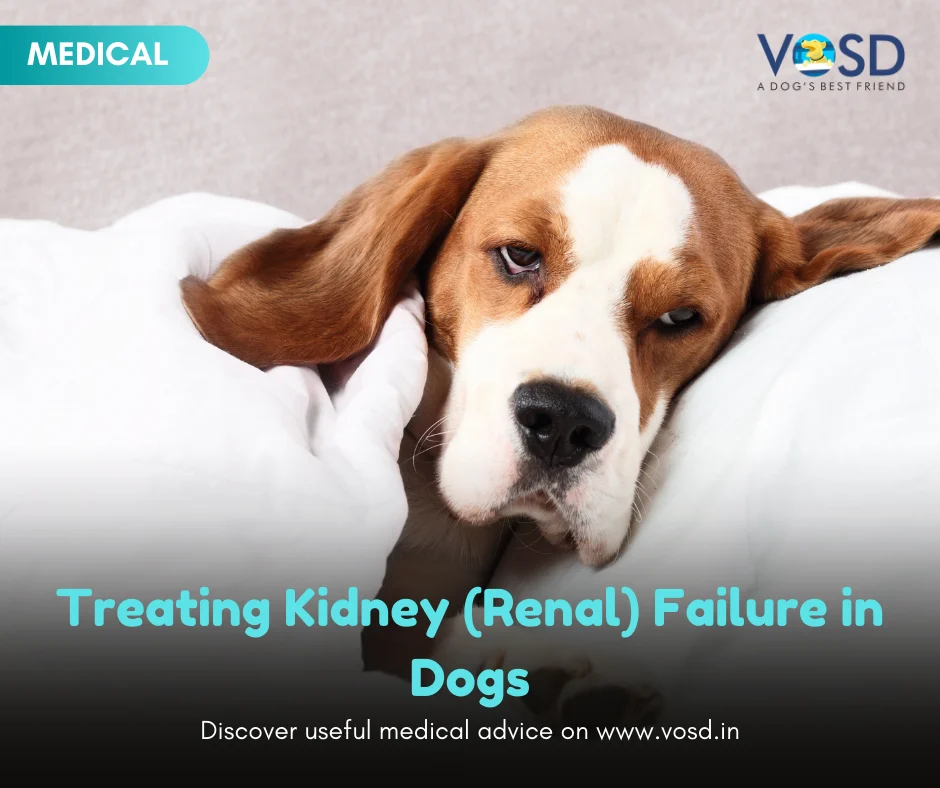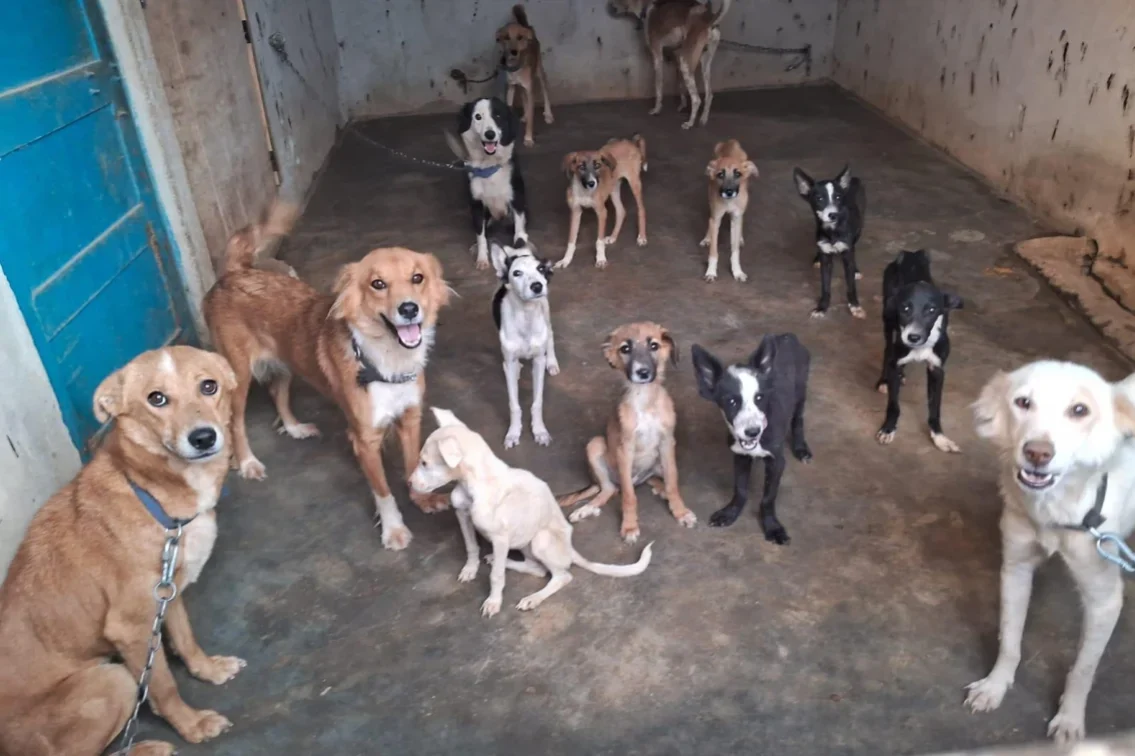Treating Kidney (renal) Failure in Dogs
Identifying and treating Kidney (renal) failure and dog kidney failure treatment
What is kidney/ renal failure in dogs?
The inability of the kidneys to remove waste products from the blood is kidney failure. Acute kidney failure in dogs is a real and dangerous possibility. The bodies of animals produce toxins all day, every day, and the toxins circulate to the kidneys to be dissolved in water, filtered out and excreted through urination. Kidney (renal) failure occurs when a dog’s kidneys are no longer able to remove waste and concentrate urine. The build-up of toxins produces the signs and symptoms of poisoning – called uremic poisoning.
Kidney failure can appear suddenly (acute kidney failure) or come on gradually over months (chronic kidney failure).
Healthy kidneys make highly concentrated urine, meaning a large amount of toxins can be handled and excreted in a relatively small amount of water. A failing kidney, by contrast, needs more and more water to excrete the same amount of toxins. A dog in kidney failure will drink increasing quantities of water, until eventually he simply can’t drink enough and toxin levels in his bloodstream begin to rise and he begins to show signs of illness or poisoning.
NOTE: These signs will now show until 75 percent of functioning kidney tissue is destroyed. Thus, a considerable amount of damage occurs before the signs are noticed. It is critical to check for renal failure at the first signs of change in urination behaviour of the dog.
Detection/signs of kidney failure
One of the first things you should notice is if the dog drinks and urinates more often. It’s a cycle of more water intake to flush toxins and more urination causing subsequent dehydration and thirst.
As kidney function declines and urine can’t be concentrated the dog retains ammonia, nitrogen, acids, and other chemical wastes in her blood and tissues. The degree of uremia is determined by measuring serum blood urea nitrogen (BUN), creatinine, and electrolytes. This stage is called uremia and comes as the last stage of acute renal failure in dogs.
Initial signs of uremia:
Uremia is the final stage of kidney failure, and indicates renal failure in dogs. The early signs of uremia include complete loss of energy, bad or foul-smelling breath and many other symptoms such as:
- Apathy and depression
- Loss of appetite and weight
- Dogs at this stage now urinate less than normal
- Ulcers may be present in the mouth.
- An ammonia like odour to the breath – best way to detect is smell the mouth or press a finger to the gums and smell the finger
Signs of advance uremia
- As renal failure progresses it may cause edema – typically retention of water in the limbs & abdomen
- Vomiting, diarrhea, and gastrointestinal bleeding
- At the end stages of kidney failure, the dog will have continuous seizures and falls into a coma
What should you do if you suspect kidney failure?
If you detect excessive drinking of water/ thirst in the dog and unusually high urination and/or loss of weight immediately get a blood test done. Kidney failure shows prominently in the blood chemistry as toxin levels (creatinine and nitrogen) rise.
Causes of kidney failure
Causes of acute kidney failure include
- Poisoning
- Tick fever & other bacterial/ viral infections especially in blood
- Leptospirosis
- Rupture of the bladder or urethra
- Shock, with inadequate blood flow to the kidneys
- Congestive heart failure with low blood pressure and reduced blood flow to the kidneys
Acute failure and but mild enough may be completely reversible.
Causes of chronic kidney failure include
Chronic renal failure is one of the most common diseases seen in older dogs, along-with arthritis and cancer. Many pet owners mistakenly think that as long as their dog is peeing a lot – often more than he did in his younger years, in fact – his kidneys are still working well. In fact, the opposite is true. So be very sensitive to urination habits in older dogs. Chronic failure is caused by Nephritis or Nephrosis.
- Nephritis is inflammation of the kidneys and is most often caused by auto-immune disorders that affect the major organs but may also be caused by infections & toxins.
- Nephrosis is any degenerative disease of the renal tubules and will severely compromise renal function
For chronic renal failure, there is no cure – the focus is on disease management for the rest of life.
Diagnosis of Kidney failure in dogs
Usually, in the case of kidney failure, the veterinarian will perform certain tests such as the urinalysis and a blood chemistry analysis. The urinalysis is to test kidney function. If there is an excess of protein in urine, it could be one of the symptoms of kidney failure in dogs.
Treating Kidney Failure
Tests and monitoring
- Dogs with kidney failure require periodic monitoring (once a month) of blood chemistry to detect changes in kidney function that may require medical intervention.
Diet
- Restrict salt intake – this helps prevent/ delay demand hypertension.
- Protein is poorly metabolised by dogs with kidney failure and increases kidney load. It’s best to put the dog on a renal diet. Dogs with weak kidneys can be thrown into uremia by feeding them more protein than they can handle.
- It is extremely important to provide fresh water at all times. The dog must be able to take in enough water to compensate for her large urine output. Some dogs will need occasional boosts to their fluid intake.
Treatment
The veterinarian should carefully monitor the blood levels, potassium levels and state of blood flow to the kidneys. If things have reached a critical place, intravenal medication will have to be transferred to remove toxins, and reducing phosphorus in the kidneys.
Two things need to be remembered – one is fluid therapy, and that the other is that half the battle is managing it in real time.
- On detection of renal failure, the No 1 priority is to give enough fluid to flush out as much of toxic accumulation as possible – and it works very well in acute kidney failure. Depending on the size and blood chemistry 3-6 bottles (300ml) of R/L may be given for the initial 5-7 days and continued thereafter.
- Restricting phosphorus intake is the other priority. Medications to lower phosphorus levels are required along with dietary adjustments.
- If the disease is the result of irreversible kidney tissue damage, in many cases renal function will stabilize for weeks, months or years at a time. And while the disease will progress and kidney function will continue to deteriorate, the dogs symptoms can be minimized with supportive treatment. After the initial fluid support dogs go into a treatment that includes
1) Azodyl/Ipakitine/Rubinal (proprietary drugs) + Renal food formulations
2) You may want to explore human grade renal medication to keep up kidney function – these includes supplements, nutrition, hormones to compensate for lost kidney function (this can be recommended to you if you request us)
- Blood transfusions to supply fresh blood that the dog may need. This has to be done carefully since new blood may itself increase kidney load but may be the best option in critical stages.
While some vets debate the efficacy of this treatment for at least 70% of the dogs in our care that were already critical we’ve been able to arrest symptoms for anything upto 6 months or more and give the dog a quality of life in this period.
Diet and nutrition in cases of kidney failure
You will have to pay a lot more attention to maintaining your dog’s diet in the case of kidney failure. Consult with the veterinarian about a solid diet plan. Your dog will need healthy fatty acids such as Omega-3. Sodium is beneficial to bringing imbalances under control. Amino acids are very healthy for dogs as well.
Prevention of kidney failure
- Many situations of acute renal failure can be prevented by ensuring dogs are kept safely away from toxic substances, heavy metals, rat poison and other pesticides, common household medicines
- Any dog with a bacterial infection, urinary obstruction or other illness that could lead to compromised kidney function should receive proper treatment, the sooner the better.
- Limiting drugs that your pet is subjected to throughout her life will reduce the amount of toxins her liver and kidneys must process. Kidney failure in elderly dogs is usually the result of worn out organs. The less stress on your pet’s kidneys, the longer they’ll do their job effectively. Get veterinary advice for dogs
Palliative care for dogs with kidney failure
If your dog is in pain and is sick, there are some things you can do to help a little bit. For one, try and keep fresh food and water available for your dog. Sometimes, if your dog isn’t hungry, warm the food ever so slightly and hand-feed the dog.
Frequently Asked Questions (FAQ)
1. What causes dog kidney failure?
Acute kidney failure in dogs is caused due to poisoning/ toxic ingestion, bacterial and viral infections in blood, bladder issues and heart diseases. Chronic kidney failure is caused by Nephritis (inflammation of the kidneys) or Nephrosis (degenerative disease of the renal tubules).
2. What are the symptoms of end stage kidney failure in dogs?
Symptoms of a kidney failure in dogs, especially in its last stage implies that 2/3 of the renal tissue has been destroyed. The visible symptoms of this include loss of appetite, increased water consumption, lethargy, diarrhea, vomiting and foul breath. In this stage, the blood toxin levels increase immensely and are very difficult to control.
3. Can a dog recover from kidney failure?
Detecting early signs of kidney failure in dogs clubbed with aggressive treatment processes yields positive results. Reversal of an acute renal failure is not possible but fluid therapy treatment and medications will slow down the process considerably, allowing your canine to lead a normal life. Be very careful of the dog’s diet to support the process and lower their salt and potassium intake.
4. Does dialysis work for dogs?
Dialysis is very beneficial for dog kidney failure treatment, especially in acute failure cases. There is a 50% chance that the dog will recover post the treatment, in absence of any underlying renal conditions. Like humans, they need to be taken for dialysis 3 times a week to relieve the symptoms of uremia.
5. How much does dialysis cost in India?
Dog dialysis in India can cost an average of Rs.15,000 per month. The high cost is due to the longevity and the frequency of the treatment that requires lifelong dialysis thrice every week. In addition, there can be supportive costs for medication and maintenance of the procedure. Very few vet hospitals in India have these facilities.
What to do next?
Disclaimer: VOSD’s recommendations are based on 250,000+ treatments that we have delivered to the dogs in our care. However please note that this recommendation while based on the tremendous experience of the best vets in the country is not specific to your dog which is not in our possession. The advice on recommended drugs and dosages is to be used as the first line of treatment if a vet is not available. VOSD is not liable for any consequences on the treatment you deliver.
For any further advice on your dog please go to VOSD Expert Advice™ | Reach us on info@vosd.in | Buy the best over the counter dog care in India from VOSD DOG CARE™ | Remember 100% proceeds of all VOSD Products & Platform fund the world’s largest no-kill dog sanctuary & rescue.





